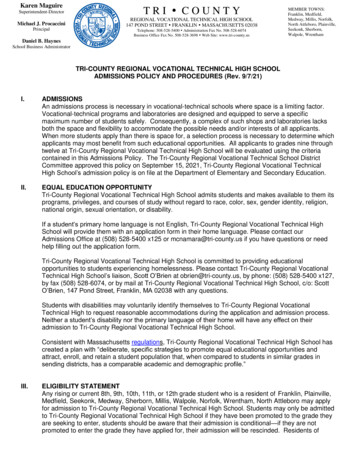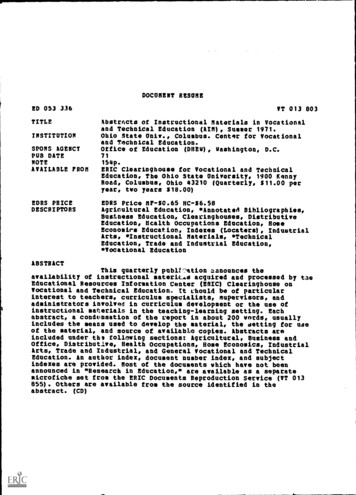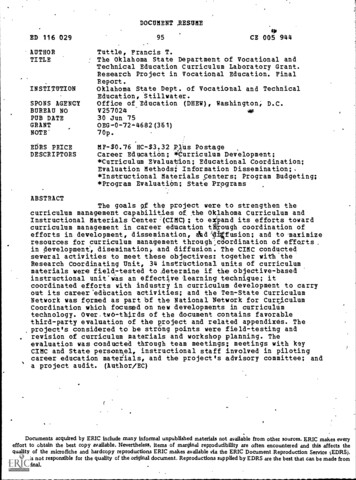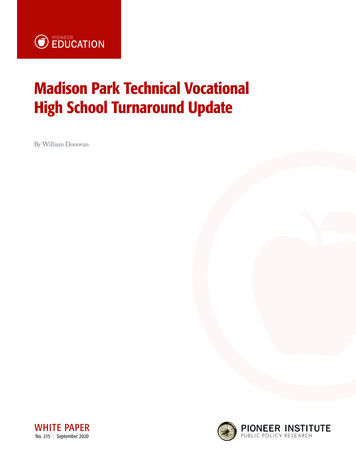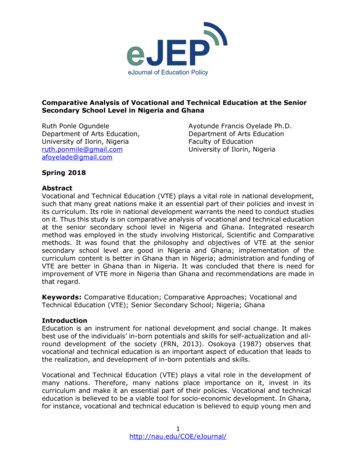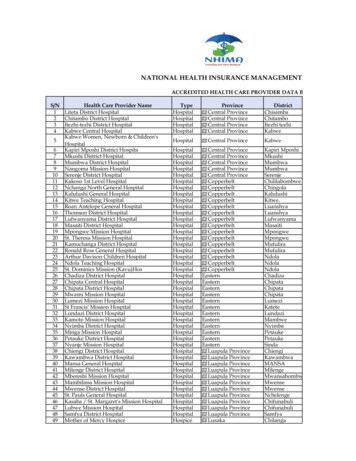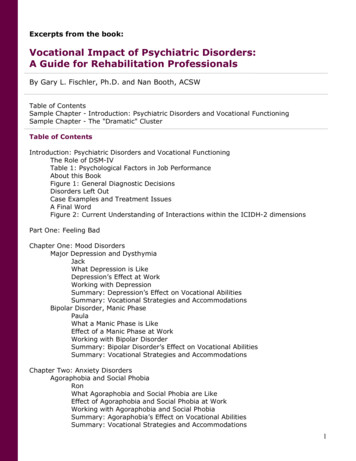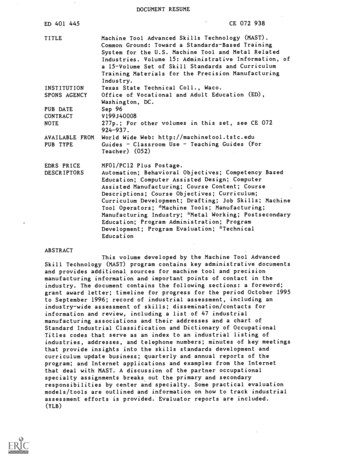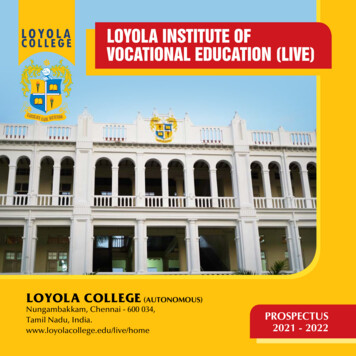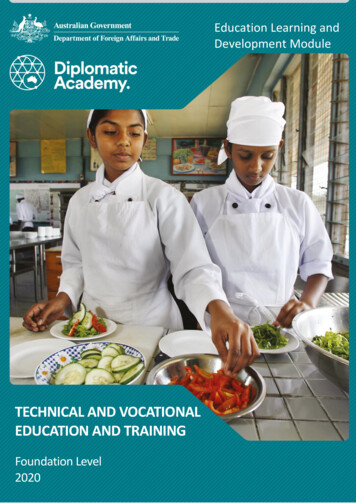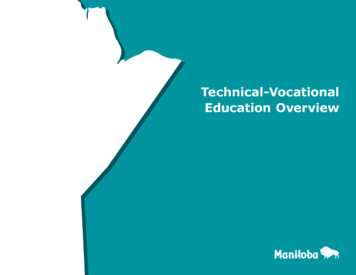
Transcription
Technical-VocationalEducation Overview
Te c h n i c a l- V o c a t i o n a lEduc at ion Overv iew2018Ma n it o b a Ed u c a t io n a n d Tra in in g
Manitoba Education and Training Cataloguing in Publication DataTechnical-vocational education overviewIncludes bibliographical references.ISBN: 978-0-7711-7739-2 (pdf)1. Occupational training—Manitoba.2. Technical education—Manitoba.3. Technology—Study and teaching (Secondary)—Manitoba.4. Vocational education—Manitoba.I. Manitoba. Manitoba Education and Training.607.12712Copyright 2013, 2018, the Government of Manitoba, represented by theMinister of Education and Training.Manitoba Education and TrainingWinnipeg, Manitoba, CanadaEvery effort has been made to acknowledge original sources and to complywith copyright law. If cases are identified where this has not been done, pleasenotify Manitoba Education and Training. Errors or omissions will be correctedin a future edition. Sincere thanks to the authors, artists, and publishers whoallowed their original material to be used.All images found in this document are copyright protected and should notbe extracted, accessed, or reproduced for any purpose other than for theirintended educational use in this document.Schools are encouraged to share this document with parents, guardians, andcommunities, as appropriate.Any websites referenced in this document are subject to change. Educatorsare advised to preview and evaluate websites and online resources beforerecommending them for student use.This resource is available on the Manitoba Education and Trainingwebsite at www.edu.gov.mb.ca/k12/cur/teched/sy tech program.html.Disponible en français.Available in alternate formats upon request.
3Technical Vocational Initiative (TVI)4TVE and Curriculum Revitalization/Review4Technology Education p Manitoba: Level 1 Standing12Non-apprenticeship Areas12Assessment and Reporting13Prior Learning Assessment andRecognition (PLAR)/Challenge for CreditSafety1314Safety-Related Learning Outcomes145Employability/Essential Skills andCareer Development15Strands in Technical-Vocational Curriculum6Employability Skills 2000 16Implementation6Fundamental Skills16Grade 9: Sampling7Personal Management16Grade 10: Exploration7Teamwork Skills16Grade 11: Specialization7Grade 12: Transition7High School Apprenticeship Program (HSAP)Curriculum Framework and Implementation5Manitoba Curriculum Framework of Outcomes7Course Goals7Learning Outcomes8General Learning Outcomes8Sample Goals and GLOs8Specific Learning Outcomes10References to Apprenticeship and Red SealObjectives/Tasks10Essential Skills17Sustainable Development andTechnical-Vocational Education18Background for Education for SustainableDevelopment (ESD)19Benefits of ESD in TVE Curriculum20References21Contentsiii
AcknowledgementsManitoba Education and Training gratefully acknowledges the contributions of the following individuals in the development ofTechnical-Vocational Education Overview.Manitoba Education andTraining StaffCarole BilykProject Manager (until 2016)Development UnitInstruction, Curriculum and Assessment BranchLouise BoissonneaultCoordinatorDocument Production Services UnitInstruction, Curriculum and Assessment BranchDino Di FabrizioProject Leader (until June 2010)Development UnitInstruction, Curriculum and Assessment BranchJohn FinchCoordinatorLearning Support and Technology UnitInstruction, Curriculum and Assessment BranchKris GrapentineDesktop PublisherDocument Production Services UnitInstruction, Curriculum and Assessment BranchGilles LandryProject Leader (from February 2010)Learning Support and Technology UnitInstruction, Curriculum and Assessment BranchDan LemieuxConsultantLearning Support and Technology UnitInstruction, Curriculum and Assessment BranchPeter NarthCoordinator (until 2013)Technical Vocational Education UnitInstruction, Curriculum and Assessment BranchKen NimchukConsultant (until 2015)Technical Vocational Education UnitInstruction, Curriculum and Assessment BranchKim PoirierConsultant (from 2016)Learning Support and Technology UnitInstruction, Curriculum and Assessment BranchMarjorie PoorPublications EditorDocument Production Services UnitInstruction, Curriculum and Assessment BranchAcknowledgementsv
Te c h n i c a l- V o c a t i o n a lEduc at ion Overv iew
IntroductionVisionWe live in a globally competitive and knowledge-basedeconomy where technological changes and a concernfor sustainability are the norm. For Manitoba’s youthto function, compete, and excel in this twenty-firstcentury environment, they require educational andtraining opportunities that are current, engaging, andresponsive to labour market needs. The goal of technicalvocational education (TVE) is to provide students withthe skills and competencies that will allow them totransition successfully into the workplace, apprenticeshipopportunities, post-secondary education, and their dailylives.Manitoba and Canada continue to experience labourshortages in the skilled trades. This problem will bemagnified by an aging workforce and too few youngpeople entering trade and technology careers. Technicalvocational education in Manitoba serves to address thosedeficiencies in the skilled trades and encourages studentsto explore career options in trades and technology. TVEprovides students with opportunities to apply theirlearning using an interdisciplinary and cross-curricularapproach while at the same time integrating learning fromtheir own personal experiences. A competency-basedframework based on learning outcomes allows a student’sprior learning to be applied and recognized, whetherobtained in a formal or informal setting.GoalsWhen students learn in an environment modelled after theworkplace, they will acquire not only trade-related skills,but will also developQQQQQQQQQQemployability skills required to make an effectivetransition from school to workan understanding of career development and planningan understanding of the importance of becoming anautonomous, lifelong learner in order to adapt to theskills and knowledge needed in the futurean awareness of safety in school, in the workplace, andat homean awareness of sustainability as it relates to the specificskilled trade area and society as a wholeIn recent history, TVE has made some significantpedagogical contributions, such as the following:QQproblem solving–based learningQQcooperative and self-directed learning and instructionQQassessment of competencies gained along a continuumQQcontextual learningQQQQintegration of academic and vocational learning andinstructionthe conscious and targeted development of work-relatedemployability and essential skillsIn order to remain innovative and current, TVE teachersmust look at educational developments and incorporatethem into teaching practices. Inquiry-based problemsolving approaches to teaching and facilitative teaching,Te c h n i c a l -Vo c a t i o n a l E d u c a t i o n O ve r v i e w3
for example, provide students with the opportunity toconstruct knowledge and incorporate their own personalexperiences into engaging and meaningful learningexperiences.The new TVE curriculum must support exploration,articulation, and mobility. Allowing students to accesstechnical-vocational education through a flexiblecurriculum model provides opportunities for morestudents to broaden their knowledge and skill set, andto explore and access more and more diverse careeropportunities. These changes and challenges have animportant impact on students, teachers, administrators,and the public, and thus clearly demand a new, flexible,and responsive curriculum model.Technical Vocational Initiative (TVI)The government of Manitoba recognized the pressingneed to address socio-economic changes, labour marketneeds, and the ability of Manitoba youth to compete ina global economy. Consequently, in 2004, the TechnicalVocational Initiative (TVI) was formed with the goal ofoffering technical vocational education programming thatwas accessible and aligned with labour market needs.The TVI mandate was predicated on six Pillars of Actiondesigned to revitalize technical vocational education inManitoba:1. Improve the image of technical vocational careers.2. Enhance awareness of technical vocationalprogramming.4Te c h n i c a l -Vo c a t i o n a l E d u c a t i o n O ve r v i e w3. Ensure programming relevance to labour market needs.4. Facilitate programming articulation between highschools and colleges.5. Develop strategies to address technical vocationalteacher currency and shortage issues.6. Increase funding to support technical vocationalequipment upgrades.Based on the Pillars of Action, TVI was engaged indeveloping an articulated, outcomes-driven approach forskilled trades education that leads to increased studentenrolment, graduation, and transition rates from highschool to technical vocational programs and increasedemployment in technical vocational careers.In 2012, the Technical Vocational Education Unit (TVEU)was formed as a unit within the Instruction, Curriculumand Assessment Branch of Manitoba Education andTraining. TVEU took over the responsibilities thatpreviously belonged to TVI. Since 2014, the LearningSupport and Technology Unit has been responsible for TVE.TVE and Curriculum Revitalization/ReviewCurriculum renewal has two main purposes:1. Review and revise existing technical vocationalcurricula so as to be current, engaging for the learner,and relevant to labour market needs, and create newcurricula as needed. This involved establishing ameaningful dialogue with industry, business, andlabour to ensure that the curricula met the above
objectives. The inclusion of innovative approaches,sustainable practices, and technology into programmingwere also important considerations in the process.2. Facilitate the dialogue and processes necessary toincrease programming mobility and articulation amongall levels of Manitoba’s education system.Through a curriculum review process involving inputfrom stakeholders, courses and programming are beingrevised, created, or deleted in order to promote currencyand relevance to industry standards and address currentlabour market needs in Manitoba. The review process wasalso cognizant of contemporary workforce requirements,sustainable practices, global competitive forces, and theneed for programming and courses to fit into the desired,seamless educational pathway.In order to facilitate interactivity and allow for rapid,ongoing response to changes, curriculum is availableonline, not in print.Technology Education ProgramTo graduate from a Senior Years Technology EducationProgram, students must fulfill the graduationrequirements outlined by Manitoba Education andcomplete a minimum of eight credits from an approvedcluster of technology education courses.Unit credit funding encourages schools to provideprogramming comprising courses from different clustersof vocational subject areas, in addition to teaching coursesfrom a specific cluster. This allows curriculum to beadapted to meet the local conditions or regional needs.High School Apprenticeship Program (HSAP)The High School Apprenticeship Program (HSAP) fallswithin the Senior Years Technology Education Program.In Manitoba, apprenticeship training, including HSAP, isadministered by Apprenticeship Manitoba. Apprenticeshipis a training relationship involving a trainee (known as anapprentice), an employer, and Apprenticeship Manitoba.An employer hires an apprentice to meet an existing orprojected skill need. A contractual arrangement, knownas indentureship, is established among the employer, theapprentice, and Apprenticeship Manitoba. Students canreceive up to eight credits from HSAP towards graduation.In some instances, in an accredited secondaryapprenticeship program, students who complete both theSenior Years Technology Education Program requirementsand HSAP can receive their full Level 1 status upongraduation. More information on HSAP can be found onthe Apprenticeship Manitoba website at ex.html.Curriculum Framework and ImplementationTo ensure credibility and relevance of content andprocesses, the specific programming and course learningoutcomes included in these documents were determinedthrough a collaborative, consensus-building model withrelevant stakeholders. Working development teamswere established that consisted of representatives fromstakeholder groups including, whenever relevant,Te c h n i c a l -Vo c a t i o n a l E d u c a t i o n O ve r v i e w5
technical-vocational schools, industrial arts programs,Apprenticeship Manitoba, community colleges,industry, and industry associations. The intention of thiscollaboration with stakeholders is to revise and developcurriculum that will facilitate articulation opportunitiesfor students.Strands in Technical-Vocational CurriculumThe general and specific learning outcomes for each coursebelong to three distinct but related strands. As studentsmove from Grades 9 to 12, the expectations within eachstrand will increase in complexity and depth and willmove the students from sampling to transition to work orpost-secondary education.Technology Fundamentals [Theory](Foundational Knowledge, Technological Literacy, Numeracy and Literacy,Sustainable Development, New and Emerging Technology)Technology Skills [Practical](Processes based on the fundamentals, tools and equipment, ICT)Professional PracticeTechnology Fundamentals: Students develop foundationalknowledge related to the area of study. Students willmake connections to cross-curricular areas that includenumeracy and literacy, sustainable development, andscientific literacy as it relates to the subject area.Technology Skills: Students develop the technologicalskills necessary to enter the related industry.Professional Practice: Students develop the knowledge,skills, and attitudes required to make a transition topost-secondary education or the workplace. Studentswill demonstrate an understanding of health andsafety standards and issues. Students will developthe employability skills to successfully continue inthe industry and explore career opportunities and theeducation and training required in the field of study.ImplementationThe implementation model for technical-vocationaleducation provides for nine credits from Grades 9 to 12.The Grade 9 credit is optional, depending on localschool resources. The eight courses developed fromGrades 10 to 12 form the foundation courses within thespecific cluster.(Health and Safety, Employability Skills, Career itionVocational (minimum of 8 core courses)Grade 9½ or 1 Credit6Te c h n i c a l -Vo c a t i o n a l E d u c a t i o n O ve r v i e wGrade 101 CreditGrade 113 CreditsGrade 124 Credits
Grade 9: SamplingThe curriculum in Grade 9 will be designed in a flexiblemodel to support sampling. The course can be offered asa half or full credit based on local school resources andrequirements.Grade 10: ExplorationStudents will explore the specific technology area.Students are encouraged to explore various technicalvocational areas.Grade 11: SpecializationStudents will specialize within the technical-vocationalsubject area of their choice. The learning outcomes will belinked to post-secondary training or apprenticeship.Grade 12: TransitionDiscussions with committee members indicated theworking document should be concise and provide enoughdirection to a teacher to implement the curriculum. Indeveloping the learning outcomes, the assumption wasmade that the courses are taught by experts in their field;therefore, the terminology and language used in thecurriculum is specific to the trade/technical area.For each subject area, the Framework consists of thefollowing:QQCourse TitlesQQCourse Grade LevelsQQCourse DescriptionsQQCourse GoalsQQGeneral Learning OutcomesQQSpecific Learning OutcomesCourse GoalsStudents will continue to specialize and develop the skillsto facilitate transition to the workplace or post-secondaryeducation. The learning outcomes will be linked to postsecondary training or apprenticeship.Each individual subject area (such as hairstyling orautomotive technology) includes between 10 and 13 coursegoals. These goals are identical in each course in thatsubject area. The goals reflect the strands in technicalvocational education as listed above.Manitoba Curriculum Framework of OutcomesCourse goals are broken down into general learningoutcomes, which are broken down into specific learningoutcomes.The Manitoba Curriculum Framework of Outcomesfor each subject area is intended to provide a guide forcurriculum implementation.Te c h n i c a l -Vo c a t i o n a l E d u c a t i o n O ve r v i e w7
Learning OutcomesLearning outcomes are statements that indicate whatstudents will know or be able to do by the end of thecourse or sequence of courses or as a result of a learningactivity. Learning outcomes are usually expressed asknowledge, skills, or attitudes. Outcome-based curriculumhas several benefits—itQQfocuses on the student’s behaviour/actionQQpromotes student engagement in learning activitiesQQQQQQQQQQQQmakes the curriculum transparent to students, teachers,parents, colleges, apprenticeship programs, andemployersenables students to learn more effectively bycommunicating the expectations of the course/sequenceacts as a template to enable teachers to design andimplement courses/sequences more effectivelyenables teachers to select an appropriate teachingstrategy for the intended learning outcome based onstudent needsenables teachers to select an appropriate assessmentstrategy for the learning outcomesprovides teachers with benchmarks for formative,summative, and prior learning assessmentCompetency-based learning outcomes lend themselveswell to TVE by providing specific, observable, measurable,realistic, and obtainable objectives to students. Learningoutcomes should be student focused and clearly outlinethe knowledge, skills, or attitudes being assessed. Within8Te c h n i c a l -Vo c a t i o n a l E d u c a t i o n O ve r v i e wa subject area, each course contains general and specificlearning outcomes that address a particular area of studyrelated to the subject area.General Learning OutcomesGeneral learning outcomes (GLOs) are overarchingstatements about what students are expected to learnin each course. They identify the broad categories ofknowledge, skills, and attitudes that students are expectedto learn and are able to demonstrate in a subject area orcourse.In an individual subject area, the GLOs might be verysimilar for each course. For example, a GLO might readsomething like, “Demonstrate the safe and appropriateoperation of equipment and utensils.” ThisGLO would be in every course in a particular subject area.However, the blank would be filled with the name of thespecific type of equipment and utensils, depending on theexact nature of the course.All general learning outcomes are identified with twonumbers indicating the subject area goal and the generallearning outcome. For example, GLO 1.1 is the first generallearning outcome under Goal 1.Sample Goals and GLOsHere are some generic course goals and GLOs typical of atechnical-vocational subject area:
Goal 1: Describe and apply appropriate health and safetypractices.GLO 1.1: Demonstrate appropriate health andsafety practices.GLO 1.2: Create and maintain a safe and organizedworkstation.Goal 2: Demonstrate the safe and appropriate operation,cleaning, maintenance, and storage of tools andequipment.GLO 2.1: Demonstrate the safe and appropriateoperation of tools and equipment.GLO 2.2: Demonstrate the safe and appropriatecleaning, maintenance, and storage of tools andequipment.Goal 3: Demonstrate the appropriate use of materials andconsumable items.GLO 3.1: Demonstrate the safe and appropriate useof the materials used in the profession.GLO 3.2: Demonstrate the safe and appropriate useof the consumable items used in the profession.Goal 4: Demonstrate the skills related to pre-production/pre-service procedures.GLO 4.1: Demonstrate the pre-production skillsrequired in the profession.Goal 5: Demonstrate the skills related to production/serviceprocedures.GLO 5.1: Demonstrate the production skillsrequired in the profession.Goal 6: Demonstrate the skills related to post-production/post-service procedures.GLO 6.1: Demonstrate the post-production skillsrequired in the profession.Goal 7: Understand career opportunities in the industry.GLO 7.1: Describe apprenticeship, education,and career opportunities, and professionalorganizations in the industry.Goal 8: Describe and demonstrate the transferable crosscurricular knowledge and skills as they pertain tothe industry.GLO 8.1: Apply mathematics knowledge and skillsrelated to the industry.GLO 8.2: Apply science knowledge and skillsrelated to the industry.Goal 9: Demonstrate awareness of sustainability as itpertains to the industry.GLO 9.1: Describe the impact of humansustainability on the health and well-being oftechnicians and consumers.GLO 9.2: Describe the sustainability practices ofthe industry and their impact on the environment.GLO 9.3: Describe sustainable economic practiceswithin the industry.Goal 10: Demonstrate awareness of the ethical and legalstandards as they pertain to the industry.GLO 10.1: Demonstrate awareness of the ethicalstandards required in the profession.Te c h n i c a l -Vo c a t i o n a l E d u c a t i o n O ve r v i e w9
GLO 10.2: Demonstrate awareness of the legalstandards required in the profession.Goal 11: Demonstrate employability skills related to theindustry.GLO 11.1: Demonstrate fundamental employabilityskills.GLO 11.2: Demonstrate an understanding ofthe business operation of a shop, salon, ormanufacturing facility.Goal 12: Understand the history, technological progression,and emerging trends of the profession.GLO 12.1: Demonstrate an understanding of thehistory of the profession.GLO 12.2: Demonstrate awareness of thetechnological progression and emerging trends inthe profession.Specific Learning OutcomesSpecific learning outcomes (SLOs) are statements thatidentify the specific knowledge, skills, and understandingsthat students are required to attain by the end of a givencourse. Teachers must teach and assess every SLO in eachcourse.SLOs do not specify the learning activities in whichstudents will participate in order to attain them. In mostcourses, the emphasis is on applied learning activities.Teachers are advised to select the learning activities bestsuited to teach the SLOs, based on a variety of factors,including access to resources or regional needs. In lightof rapid changes in technology, business, and industry,10Te c h n i c a l -Vo c a t i o n a l E d u c a t i o n O ve r v i e wteachers are encouraged to update their learning activitiesin order to meet the needs of students.SLOs do not specify the location where the SLOs aretaught. This means that any course can be taught in themost appropriate location, such as a regular, academicclassroom, a shop or lab, or an authentic industryworkplace location, such as a shop or salon.SLOs are not necessarily sequential. In other words,they might be taught in an order different from how theyappear in the document.All specific learning outcomes are identified with asequence of numbers separated by dots. These characterscode the general learning outcome and the specificlearning outcome. For example, SLO 1.1.1 is the firstspecific learning outcome under GLO 1.1.References to Apprenticeship and Red SealObjectives/TasksIn Apprenticeship and Red Seal subject areas (exceptcarpentry), the Framework contains all of the Level 1objectives/tasks from either Apprenticeship Manitoba (e.g.,cook) or Red Seal (e.g., baker). Those Apprenticeship or RedSeal learning outcomes/objectives/tasks are referenced inbrackets at the end of some Frameworks. In some cases, theApprenticeship or Red Seal learning outcomes/objectives/tasks have been reworded to make them more consistentwith the wording in the Framework.Teachers teaching Apprenticeship subject areas mustfollow the objectives in those curriculum documents asclosely as possible to ensure that students have met the
Level 1 requirement for their subject area. They shouldread the Trade Level Unit Outlines from Apprenticeship toget more detailed information about the Apprenticeshipobjectives. They will find them, along with the Red Sealcurriculum, to be valuable resources. These documents canbe found here:QQQQApprenticeship Manitoba Technical TrainingCurriculum Information: g.htmlEffort is being directed toward creating seamless pathwaysbetween programming at the high school and postsecondary levels and ensuring that graduating studentsmeet entry-level workplace industry skills standardsand, where appropriate, learning outcomes equivalent tofirst-year post-secondary or Level 1 Apprenticeship. Thisallows for increased mobility across education systemsboth within Manitoba, and for the Red-Seal trades, acrossCanada.Interprovincial Standards Red Seal Programwww.red-seal.caArticulation in the following areas has been targeted withthis curriculum development:ArticulationFigure 1Articulation PathwaysQQbetween Middle Years and Senior YearsQQwithin individual high schoolsQQamong Manitoba high schoolsQQbetween high schools and collegesQQbetween high schools and Apprenticeship ManitobaQQbetween high schools and the workplaceBefore and during the completion of Senior Yearstechnical-vocational education and/or the High SchoolApprenticeship Program (HSAP), options includeindustrial arts courses or human ecology courses inMiddle years, academic programming, part-time/summeremployment, and personal learning experiences. After thecompletion of Senior Years technical-vocational educationand/or HSAP, options include private/industry training,apprenticeship, community college, and universities asvarious pathways to the world of work.Articulation is based on the premise that institutionshave a responsibility to establish connections betweenthemselves so that the repetition of learning is limitedTe c h n i c a l -Vo c a t i o n a l E d u c a t i o n O ve r v i e w11
or does not occur at all. Articulation agreements are aninstitutional response to the need to recognize the skillsand learning previously achieved at other institutions.AccreditationApprenticeship Manitoba requires that a Senior YearsTechnology Program must be accredited to offer Level 1 ofthat specific trade. Accreditation of a subject area within aschool is based on the following general criteria:QQQQQQlicensed journeyperson as a teacher in the subject areafacility requirements as outlined by ApprenticeshipManitobacurriculum aligned to Apprenticeship Level 1 for thespecific areaApprenticeship Manitoba has used a standard benchmarkin assessing suitability of accreditation submissionsrelative to Apprenticeship Manitoba’s Level 1 curriculumcontent standards. Submissions must have 100 percent ofthe curriculum objectives that are outlined in Level 1 ofany given Apprenticeship curriculum.Following the guidelines established by ApprenticeshipManitoba, each subject area curriculum developed willhave a benchmark document that indicates where in theTVE curriculum the Apprenticeship objectives are beingmet. This document will assist secondary schools inobtaining accreditation in that subject area. For additionalinformation about accreditation, contact the accreditationcoordinator at Apprenticeship Manitoba.12Te c h n i c a l -Vo c a t i o n a l E d u c a t i o n O ve r v i e wIt is the expectation of Manitoba Education and Trainingthat schools offering vocational programming, whereapprenticeship exists, have their programming accreditedthrough Apprenticeship Manitoba.Apprenticeship Manitoba: Level 1 StandingA student who graduates from an accredited Level 1training program with a minimum final accumulativeaverage of 70% or better in the trade subject for whichthe program is accredited is entitled to receive technicaltraining standing in addition to 900 hours towardspractical training upon entering apprenticeship, providedthe standards outlined by Apprenticeship Manitoba aremet.Students completing the accredited program are requiredto complete their practical training in order to receivefull standing as a Level 1 apprentice. In some instances,the outstanding hours required to complete the practicaltraining component can be done within the High SchoolApprenticeship Program.Non-apprenticeship AreasIt is expected that schools offering programming thatis not in a designated trade and thus not accreditableby Apprenticeship Manitoba will seek articulationagreements with their local community college oruniversity. In these agreements, students would beawarded course credit based on meeting the learningoutcomes established by the receiving institution andan agreed upon level of performance (e.g., a final gradeof 70%).
Assessment and ReportingAssessment is an integral part of learning. It plays a majorrole in how students learn, their motivation to learn, andhow teachers teach. Learning is viewed as a process ofconstructive understanding, during which individualsattempt to connect new information to what they alreadyknow, so that ideas have some personal coherence.Individuals construct this understanding in manydifferent ways, depending on their interests, experience,and learning styles (Manitoba Education, Citizenship andYouth, Rethinking 3).In this model of TVE, formative assessment is used tohelp students to construct knowledge and skills. At times,assessment needs to be summative in nature in order tocommunicate student learning. Suggestions for assessingand reporting student achievement of the learningoutcomes are offered in other departmental documents:QQQQRethinking Classroom Assessment with Purpose in Mi
a global economy. Consequently, in 2004, the Technical Vocational Initiative (TVI) was formed with the goal of offering technical vocational education programming that was accessible and aligned with labour market needs. The TVI mandate was predicated on six Pillars of Action designed to revitalize technical vocational education in Manitoba: 1.
